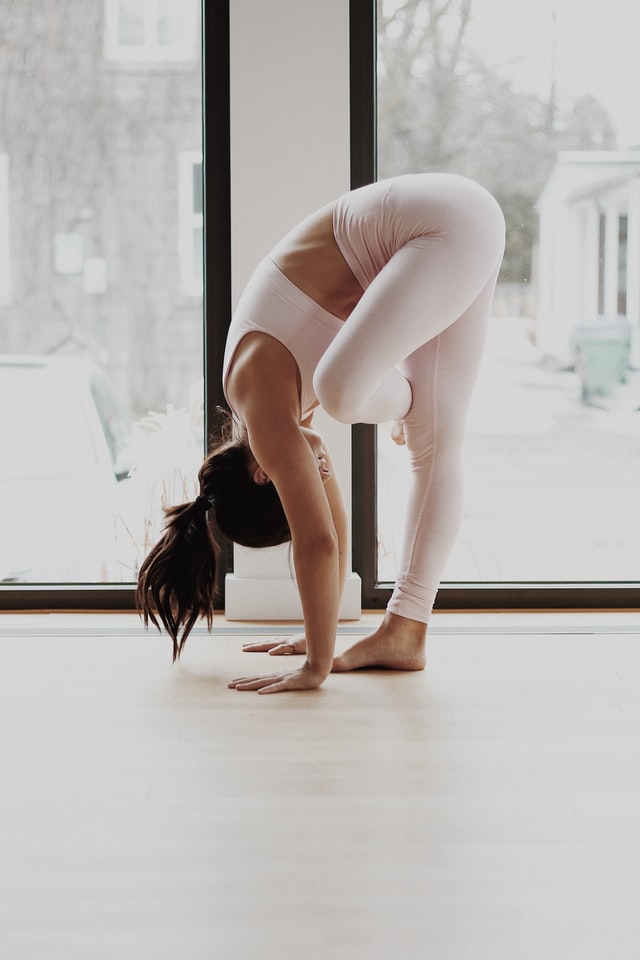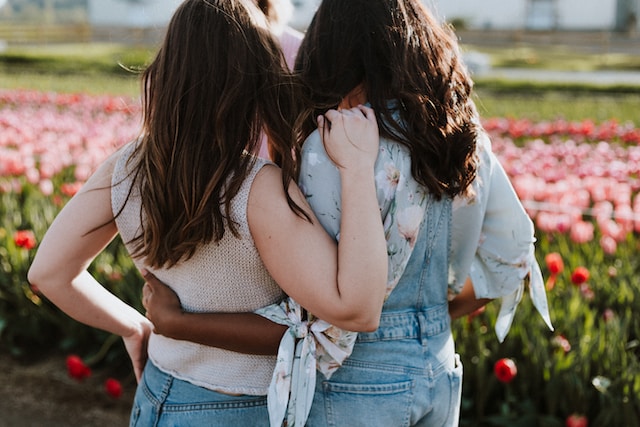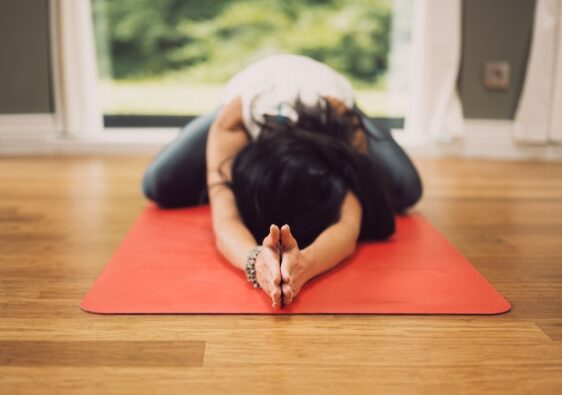Yoga for Grief, Trauma, and Depression – A Journey From Darkness To Inner Peace
Hi, I am Nicolle and this is my journey through the shadowy realms of grief, trauma, and depression, and how yoga offered me a pathway towards self-discovery and healing.
Table of Contents
Life is never straightforward; it throws its challenges at us, and like many other people, I found myself going through a dark period.
I had been struggling with anxiety and depression for most of my life, meaning I was familiar with darkness, but the loss of both my parents in less than two years completely shook up my world and belief systems.
In yoga, I found an outlet for grief, trauma and depression.
Through regular practice, I learned to ground myself, let go of fear, embrace trust, and connect with the healing power of my heart.
Yoga for emotional healing is real. It certainly is in my story.
I am not gonna lie to you, it has been a pretty wild rollercoaster of emotions (it still is) and when I started my journey there were certainly more downs than ups, but each time I stepped on the mat, it felt like I was coming closer to home.
Yoga offered me a gateway to my emotions and along this journey of self-discovery, I found my truth and the key to living a more authentic life, which is led by the heart rather than the mind.
Today I am sharing my journey, as always unfiltered and I will tell you exactly how and why yoga became my rock helping me to work through grief, trauma and depression.
Before we start, please note that I am not you, I am not a counsellor, and what helped me might not necessarily work for you. This is my truth, and I believe that truth is different for everyone. Yet I also believe in the power of sharing experiences, and if you read this and know that you are not alone, or it helps you to get a different perspective, I think this is all that matters.

Definition of grief
Grief is a natural response to loss. It is the emotional pain one feels when something or someone significant is taken away.
There are different types of grief. To be completely honest with you, this was news to me.
I always thought that grief means grieving the loss of a loved one, but grief is not limited to the loss of a loved one; it can also arise from the end of a relationship, the loss of a job, health challenges, traumatic experiences throughout life, or any other significant life changes.
The pain of grief can feel hugely overwhelming, and it is an experience that affects everyone differently.
Reading tip: Learn more about the different types of grief here.

Emotional and physical effects of grief
As mentioned, grief feels different for everyone and it affects everyone differently.
However, there are some common emotional and physical effects of grief most people are likely to feel at some point along their grieving journey.
Emotional effects of grief
- Sadness – a deep sadness and a sense of emptiness can be common emotions during grief
- Anger – feelings of anger or resentment towards the situation, oneself, or others can arise
- Guilt – one might experience guilt over things left unsaid or undone
- Anxiety – fear and anxiety about the future without the person or thing lost can arise
- Confusion – difficulty concentrating, making decisions, the ability to focus, can be part of the grieving process
Physical effects
- Fatigue – grief can be exhausting, leading to low energy and tiredness
- Disrupted sleep patterns – insomnia or oversleeping can be common issues faced by those grieving
- Appetite changes – grief can cause a loss of appetite or overeating as a coping mechanism
- Physical pain – headaches, stomach aches, and muscle pain can result from the stress of grief
- Weakened immune system – the stress and emotional strain of grief can weaken the immune system, making one more sensitive to illnesses
Learn more about the effects of grief and how grief affects your body here.
Grieving is a deeply personal journey, acknowledging its impact is the first step towards healing.
I found myself at a crossroads
Grief didn’t hit me for some time, well…I blocked out all the feelings and emotions related to it and continued my life almost as if nothing had happened.
I found refuge in work and easily rocked 50 – 60 hours each week. Work kept me going during the week and at the weekends I would crush out sleeping all day Saturday and Sunday. Coming Monday morning I would do it all over again.
I continued doing this for months, almost reaching one year. What your body is capable of in these moments of challenge is pretty impressive.
My body felt numb, It had been for some months, yet my mind was racing 24/7 and at some point, my anxieties had reached a new high.
I looked for help in therapy. Therapy used to be a great support in the past with my anxieties. But somehow, this time around, therapy didn’t bring me the effect I was hoping for.
Don’t get me wrong, I highly recommend working with a therapist especially when it comes to grief.
However, I started to feel that this time, I needed a more holistic approach.
And whereas my therapist strongly advised me to take a break and spend some time in rehab, I decided on a plot twist.
For some weeks, I had felt this urge to go to Hawaii and do yoga at the beach. Back then, I didn’t know why I felt this urge or what this urge was, but today I know it was my soul guiding me.
Apart from the fact that it sounds like the perfect escape plan, there was nothing to lose.
I took a month off work and flew halfway across the globe to Hawaii to join a Kundalini yoga retreat.
I hadn’t been on a yoga mat for almost 10 years, and I had no clue what Kundalini yoga was, I liked the location and the sound of the retreat, so I booked it.
If you don’t know what Kundalini yoga is, let me tell you that Kundalini yoga is not your average yoga class.
In a Kundalini yoga class, there is chanting, breathwork, movement, etc. the whole package and people are usually dressed in white.
Now, I am a goth by heart 🖤 and the first day I certainly thought that I ended up in a cult.
I met the extreme, but it was exactly what I needed and this is where my healing and self-discovery journey started.

The healing power of yoga
Grief is not a linear process but a series of waves, each different from the last.
Grief affects us physically, emotionally and spiritually, creating a sense of imbalance. Yoga can help restore this balance and inner peace by fostering a deep connection between body, mind and spirit.
Below are three ways how yoga helped me work through grief and the emotions that came with it.
Little did I know, but it was very much like opening Pandora’s box…
Yoga for emotional release
“E-motions are energy in motion. If they are not expressed, the energy is repressed. (…)”
John Bradshaw
Any negative emotion such as grief or trauma, that we experience in life creates tension, a physical tightness, within the body.
If we suppress these emotions, over time, the energy becomes stagnant. On the outside, these stagnant emotions can manifest and show in other ways such as anger, depression, anxiety, chronic diseases, unhealthy behaviour patterns, coping mechanisms, etc.
Mindful movement, such as yoga, can help release these stagnant emotions.
The physical practice of the asanas (yoga poses) helps to open up the body, creating space, and allowing the energy and emotions to flow.
By synchronizing breath with movement yoga encourages a connection between body, mind and soul, opening us up to our inner world, and allowing us to become more aware of our body’s sensations and internal emotions.
This heightened sense of awareness can help us recognize and release the physical manifestations of grief and trauma, stored in the body.
I still remember these first movements on my mat. Every movement felt so natural to me, liberating and energizing. After a few days of morning yoga, the numbness in my body slowly disappeared and I could finally feel my body again.
Connecting with my inner world, and my emotions, was challenging at first.
I am a very analytical person, yes, that is the German in me speaking. In therapy, I learned how to analyse certain situations and related feelings, but one thing I never got from therapy was how to release and work through these suppressed emotions.
Yoga offered me an approach to working with and through these emotions.
Yoga teaches you not to judge, there are no good or bad emotions. Instead, you learn to give these emotions space and by giving them space, you allow them to be.
By allowing these emotions to be you get an opportunity to work through and with these emotions.
I learned that each emotion serves as a guide to understanding ourselves better, helping us navigate our experiences in this 3D world with greater awareness and wisdom.
Fear for example teaches you about areas where you feel vulnerable.
Anger teaches you more about your boundaries and core values.
Sadness teaches you a deeper appreciation for joyful moments and happiness.
Guilt encourages self-reflection.
And grief is the key to self-love.

Emotional release through conscious breathing
When we experience grief, our sympathetic nervous system (responsible for the ‘fight or flight’ response) can become overactive, leading to heightened stress levels. This was certainly the case for me.
Conscious breathing activates the parasympathetic nervous system, which induces a state of relaxation and calm.
By focusing on the breath, we shift our attention away from distressing thoughts and emotions. Over time, the mind becomes clear and free from any thoughts, judgments, or fears, helping us create a sense of peace and grounding from deep within.
The healing power of conscious breathing:
- Physical relaxation – conscious breathing promotes physical relaxation by encouraging the release of muscle tension and improving overall body awareness
- Emotional regulation – conscious breathing helps regulate our emotional responses, making it easier to manage the ups and downs of grief as it allows us to remain more present and calm
- Increased mindfulness – conscious breathing fosters mindfulness by bringing our awareness to the present moment; this mindful presence helps us to observe our grief without judgment, creating a space for healing and self-compassion
Learning how to consciously breathe was a game-changer for my anxieties as I finally had a tool to help quiet my mind and relax in situations of distress and discomfort.
What I learned is that your breath is a great ally as you go through life as your breath can tell you a lot about who you are and give insights into your emotional world and emotional state of being.
It certainly was a bit of trial and error for me to find which breathing techniques work best for me but next to yoga, breathwork became part of my daily morning routine.
It still is and helps me stay rooted and grounded as I go through the day.
The two breathwork exercises I do every morning are called fourfold breath and alternated nostril breathing. Both breathwork techniques are super soothing and grounding.

Meditation for grief and loss
Meditation can be another powerful ally in the journey through grief, offering a compassionate and effective way to process emotions, help you reduce stress, and find inner peace.
Similar to yoga, meditation teaches the principle of acceptance, acknowledging things as they are without trying to change them.
By observing your feelings and emotions without judgment, you get the opportunity to generate more self-awareness which is the first step towards understanding and processing your emotions.
In the stillness of meditation, you can allow yourself to first feel and then release emotions that might be difficult to confront in your daily life.
I never thought I could sit still and it took me a lot of practice and patience, but I stuck with it and over time, meditation became my ‘safe place’.
A place where I allowed myself to feel whatever it was that needed to come up. A place where I felt safe to cry and release.
Tip: Guided meditations are a great way to start. I recommend trying the Love and Kindness Meditation and this Body Scan Mediation to begin with.

How yoga turned into a lifestyle
For me, the benefits of yoga on my mental health and well-being showed instantly and after the yoga retreat in Hawaii, I continued practising yoga and started a daily home yoga practice. In addition to my home yoga practice, I also joined a yoga studio close by.
Over the years, yoga became more than just a practice, yoga turned into a way of living that supports my physical and mental well-being in many ways.
Through yoga, I learned more about mindfulness activities and intentional living which completely changed my way of living.
Mindfulness activities such as journaling or practising gratitude became part of my daily routine. Both help me to stay grounded, ease my anxieties and keep a positive mindset.
Yoga also changed the way I saw my body. For years I had pushed my body to the extreme through highly intense workouts, crazy stupid diets, exhausting work hours, and much more. Yoga taught me to work with my body rather than against it.
I started to look more after myself and my body. I introduced self-care practices and began to make healthier choices that nurture my body and my mind. I became more conscious of what I consume, not just in terms of food, but also when it comes to social media, TV series, podcasts that I listen to, people I surround myself with, thoughts that are not serving me, etc.
I became more aware of myself, my emotions and my wellbeing which also encouraged me to set healthy boundaries for myself allowing me to better protect my mental and emotional space.
Yoga philosophy gave me so much inspiration and one of the biggest learnings is impermanence. Everything in this world follows a natural cycle, expansion and contraction, growth and decline, the ups and downs in life.
I learned that nothing lasts forever, it is a natural law, a given from Mother Earth.
But most importantly I got to understand that these moments of contraction are as important as these moments of expansion. In fact, we are here to experience both. This is part of being human and if we want to get the most out of this lifetime we need to embrace both, the good and the bad, as both positively contribute to our self-awareness and personal growth.
As humans, we are here to explore the full range of emotions. Yoga taught me to open myself up to these moments of contraction, accept them for what they are and take them as a learning rather than a burden.
Yoga also taught me that nothing in this universe ever gets lost and that everything is interconnected, beautifully woven together and this goes beyond this planet, this lifetime, this experience.
The more I got to understand myself, the better I got to understand them and every step I took (and still take) towards my healing, I also take for them.
Yoga is a journey of self-awareness, embodying peace, self-acceptance and forgiveness.
How to start a home yoga practice
If you are looking to try yoga for emotional release, I recommend starting a home yoga practice.
Having a regular home yoga practice offers many benefits: convenience and flexibility, cost-effectiveness, increased consistency, a more personalised practice and the benefit of practising in the comfort of your home which can be easier when you are going through a difficult time.
Yoga is very accessible and there isn’t much yoga equipment required to start a home yoga practice.
Below are a few tips to help you get started:
- Find the right space in your home – find a quiet space in your home with minimal distractions and make sure that you have enough space to move freely
- Find a yoga style and online teacher – decide on the yoga style that you like and check out a few online videos with different teachers to find a teacher you resonate with
- Be consistent – block the time for your yoga practice in your dairy; consistency is key if you are looking to build a strong foundation for yourself
A regular yoga practice can provide a sense of stability and comfort, helping you navigate the complexities of grief with more compassion and strength.
Let Your Shadow Shine Yoga
If you are ready to give yoga for grief a try, join me for a beginner-friendly yoga flow in magical Costa Rica 🖤.
Embrace community
I love having a home yoga practice but don’t underestimate the power of community.
Grief can be an isolating experience, finding a supportive community can significantly support the healing process.
Check out local yoga studios. A community offers a sense of belonging and reminds us that we are not alone in our struggles.
And some yoga studios offer specifically designed yoga classes and workshops on yoga for grief.

Yoga, breathwork and meditation…what all three have in common is using your breath to help guide you and connect with your internal emotional world.
In yoga, breath is also referred to as ‘life force energy’. It all starts with a breath and it all ends with a breath. Your breath is a powerful tool and it can tell you a lot about your truth and who you are as a person.
Yoga has been my rock through some of the hardest periods in my life and it still is my daily support net that helps to keep me grounded and rooted.
I truly believe in the power of yoga for emotional healing and if you have any questions about yoga for grief, please feel free to leave me a comment below or reach out via email.
I am a certified yoga teacher and if you are looking to start yoga I would love to support you along your journey. Check out my weekly schedule and free online yoga classes. In addition, sign up for my newsletter to stay on top of my latest workshops, yoga retreats and blog updates. I would love to see you on the mat.
Stay wild,
Nicolle
Hi, I’m Nicolle, a certified Personal Trainer, Yoga Teacher, and Blogger. I’m the founder of Let Your Shadow Shine and the voice behind this blog — your space for fitness, well-being, and self-discovery. On this blog, you will find empowering movement practices, holistic well-being tips and personal growth inspiration, all helping you to live with intention and create a life aligned with your inner truth.






Faith and positive thinking help me to deal with difficulties. Prayer helps me to face my fears. Deep breathing and meditation are great for my anxiety and trauma. I do pilates/yoga stretching as the physio exercises that help me enormously with my back pain after my accident.
Such beautiful words! Breathwork and meditation made such a huge difference for me too! Thanks so much for your comment.
Not in my best state, mentally, these past few days. I will definitely try this and I’m sure it’s gonna work wonders x Thank you!
Sending you lots of love and light, Martina! Thank you so much for your comment xx
I need yoga. I have known for a while that I need to make time for this. Bookmarking and will return for inspiration later, thank you!
Thanks so much, Tammi!! If you are interested in starting a home yoga practice, check out the other blog posts within the yoga category, you might find further inspiration there!!
I really need to give yoga another go. I feel like I have alot of stuff to work through, and I think some, prayer, yoga, and journaling my be the way to go. I am hoping once my kids go back to school in a couple weeks, I’ll be able to dedicate a little more time to self care and working through the things I need to. This post was a great post! Thanks for sharing.
You are very welcome, Ashley!! Hope you get to catch up on your self-care time. And if you do decide to give yoga another go, feel free to check out my weekly schedule. I have a lot of free videos available on Youtube. Would be great to see you on the mat!!